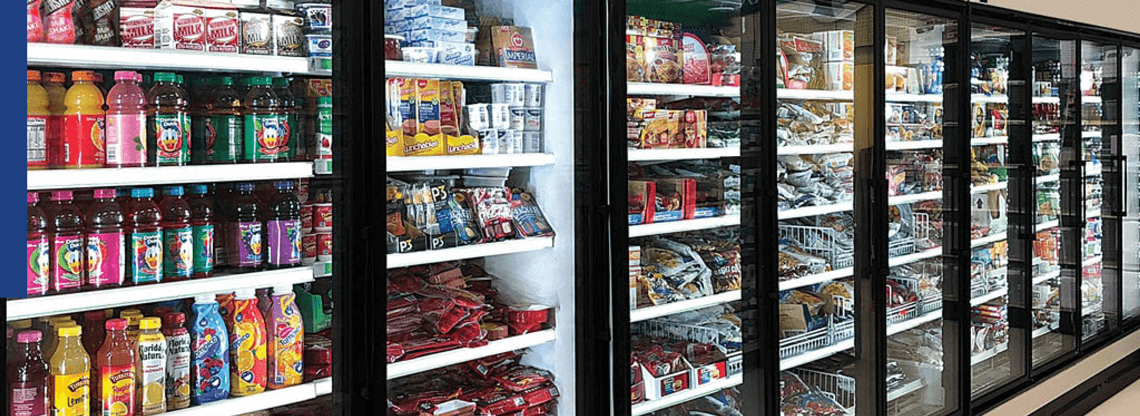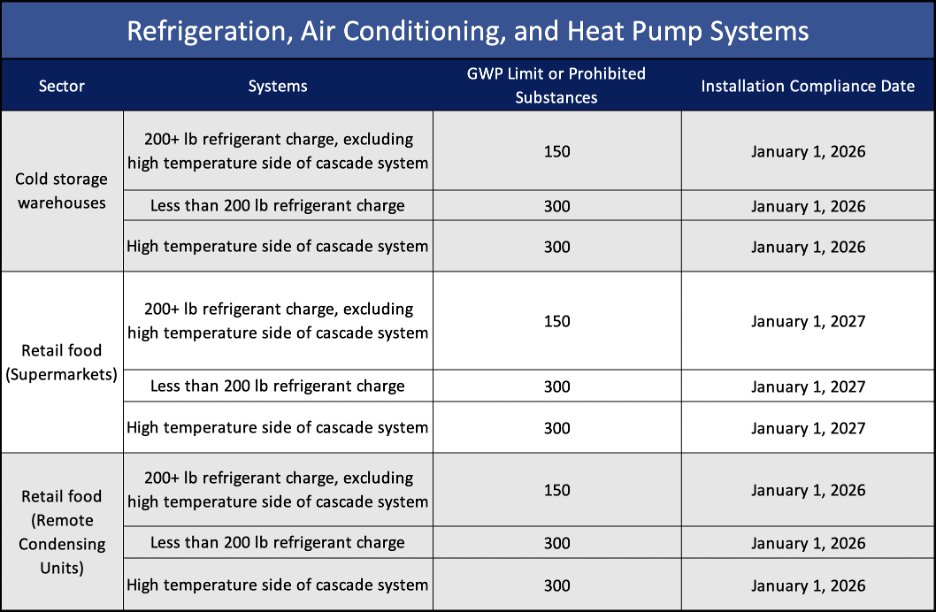How Does the Finalized AIM Act Rule Impact Your Operation?

Earlier this month, the EPA announced its final ruling on Technology Transition Rule portion of the AIM Act, which will phase down hydrofluorocarbons (HFCs) in several industries.
According to the act, the primary goals are to reduce emissions of climate damaging HFCs from equipment such as air conditioning and refrigeration systems, and maximize the amount of HFCs that can be reclaimed.
Because some things have changed from the original proposal of the AIM Act, we wanted to keep you updated on how the final ruling stands. The updated version of the AIM Act features important details on the finalized Technology Transition Rule, which may impact your operation.
Technology Transition Rule
Self-Contained Refrigeration, Air Conditioning, and Heat Pump Products
The Technology Transition Rule impacts self-contained refrigeration, air conditioning, and heat pump products. A major impact of this rule is it prohibits:
- The manufacture and import of products that use higher Global Warming Potential (GWP) HFCs after January 1, 2025.
- The sale, distribution, and export of products with higher-GWP HFCs after January 1, 2028.
- The installation of new RACHP systems that use higher-GWP HFCs.

What Is a “Stand-alone Unit”?
The AIM Act defines stand-alone units as equipment where all components are integrated and, for the smallest types, the refrigeration circuit is entirely brazed or welded.
Stand-alone units are charged with refrigerant at the factory and typically require only an electricity supply to begin operation.
Examples of stand-alone units: Refrigerators, freezers, and reach-in coolers (either open or with doors).
Refrigeration, Air Conditioning, and Heat Pump Systems
A major change in the finalized ruling of the AIM Act comes with the deadline and the benchmark of compliance for systems. It focuses more on the installation date of systems instead of the manufacture date.
- For Supermarkets, the Installation Compliance deadline for is now January 1, 2027.
- Cold Storage Warehouses, Industrial Process Refrigeration and Remote Condensing Units have a deadline of January 1, 2026.
- Important: That means your refrigeration systems must be installed and charged by these dates.
- You will need to account for commissioning, contracting, ordering, lead times and everything else that is involved prior to a system being installed and charged.

How Does the EPA Define “Install”?
“To complete a field-assembled system’s circuit, including charging with a full charge, such that the system can function and is ready for use for its intended purpose.”
What About Maintenance of Legacy of Systems?
This rule does not restrict the continued use of any existing products or RACHP systems.
According to the final ruling, a product/system may be serviced and repaired throughout its useful life – including replacing components, as needed. Components needed to repair existing RACHP equipment may continue to be manufactured, imported, sold, distributed, or exported. In this rule, EPA defines the distinction between maintenance of a system and installation of a new system.
Specifically, the following actions, upon charging the system to full charge, are considered a new installation of a RACHP system and thus subject to the relevant HFC use restrictions:
- Assembling a system for the first time from used or new components
- Increasing the cooling capacity, in BTU per hour, of an existing system, or
- Replacing 75% or more of evaporators (by number) and 100% of the compressor racks, condensers, and connected evaporator loads of an existing system
How Will Reporting Be Handled?
The EPA is requiring annual online reporting from manufacturers and importers of products and specified components of RACHP equipment. It begins with 2025 data (calendar year) and is due 90 days after the start of each calendar year.
The first reports submitted by OEMs and importers are due March 31, 2026. The EPA plans to conduct a series of trainings and stakeholder outreach for reporting implementation.
Proposed Emissions Reduction and Reclamation Program
The Emissions Reduction and Reclamation Program portion of the AIM Act is still in the proposed phase, but retailers should be aware that a new rule about service and repair practices is looming on the horizon.
This is the first proposed rule under subsection (h) of the AIM Act, “Management of Regulated Substances.” The primary goals are to establish a program (Emissions Reduction and Reclamation Program) to reduce emissions of HFCs from equipment such as air conditioner and refrigeration systems, as well as maximize the amount of HFCs that can be reclaimed.
The EPA will be holding a public hearing after the rule is published to the Federal Register, and will accept public comment for a 60-day period regarding the ruling.
We will keep you informed when there is news on this proposed rule.
Highlights from the EPA’s FAQs
In response to some ambiguities throughout the finalization process, the EPA released answers to some frequently asked questions.
Click here to view the full Q&A.
Can I replace a part or component on my R-404A or R-407A supermarket system in my store after January 1, 2027?
Yes. Stores can maintain and repair legacy systems throughout the useful life of the equipment.
Can display cases be replaced with like product in 2028 with cases that were built in 2027 (or 2020)?
Display cases are components and can be replaced regardless of manufacture date.
Can display cases be replaced with different cases in 2028, removing three open cases and installing six cases with doors to reduce energy consumption?
More energy efficient display cases may be installed so long as the cooling capacity of the system in BTU/hr is not increased. Increasing the cooling capacity of the system triggers the requirements of a new system.
Can I retrofit my R-404A or R-407A supermarket system to use R-448A or R-449A after January 1, 2027?
Yes. The Technology Transitions rule does not address the retrofit of legacy systems.
Have More Questions?
If you have any questions regarding the AIM Act or other refrigeration regulations, please don’t hesitate to reach out to our experts:
Scott Martin
Senior Director of Industry Relations and Compliance
770-285-3104 (Office)
404-915-9924 (Cell)
Derek Gosselin
Director of Technical Product Support
678-372-4111 (Cell)
Subodh Sharma
Director Product Management: Systems
470-532-5203 (Cell)